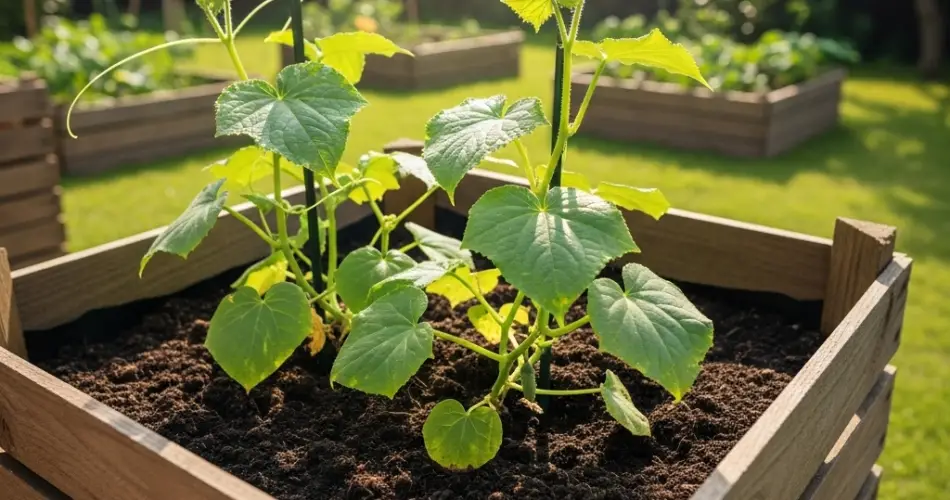Growing cucumbers on a balcony or small patio is easier than you might think, especially when using DIY crate beds. These simple, space-saving containers offer a perfect environment for cucumbers to thrive, providing good drainage, aeration, and enough room for roots to develop. Whether you’re a beginner or an experienced gardener, crate beds make fresh, crisp cucumbers accessible, even without a traditional garden plot.
Why Choose Crate Beds for Cucumbers?
Wooden crates are an excellent choice for container gardening because they’re sturdy, reusable, and offer natural breathability that helps regulate moisture levels. They are deep and wide enough to accommodate cucumber plants, which have vigorous root systems.
Using crates also makes it easy to customize your garden’s layout on a balcony or patio. They can be stacked, grouped, or placed wherever there is sufficient sunlight, maximizing your growing space.
Materials You’ll Need
To create your own crate bed for cucumbers, gather the following:
-
Wooden crates (at least 12 inches deep and 18 inches wide)
-
Landscape fabric or burlap sacks for lining
-
Quality potting soil rich in organic matter
-
Cucumber seeds or seedlings (choose compact or bush varieties for containers)
-
Organic fertilizer or compost
-
Trellis or vertical support for vines
-
Watering can or hose with a gentle spray nozzle
Preparing Your Crate Bed
Begin by lining the inside of your wooden crate with landscape fabric or burlap. This prevents soil from leaking through the slats while still allowing water to drain. Ensure the crate has sufficient drainage holes or gaps to avoid waterlogging.
Fill the crate with a well-draining potting mix enriched with compost. Cucumbers prefer loose, fertile soil that retains moisture but doesn’t stay soggy. Avoid compacted garden soil, which can stunt root growth.
Selecting the Right Cucumber Variety
For container gardening, opt for compact cucumber varieties that don’t require sprawling space. Some good options include:
-
Bush cucumbers: These stay compact and produce well in containers.
-
Pickling cucumbers: Great for making homemade pickles and grow well in crates.
-
Mini cucumbers or snack cucumbers: Smaller fruit but high yield, perfect for balcony growers.
Choosing a variety suited for containers ensures manageable growth and better yields.
Planting Your Cucumbers
If starting from seeds, plant 2–3 seeds per crate about 1 inch deep, spaced evenly. Once seedlings emerge and grow their first true leaves, thin to the strongest plant, leaving just one or two plants per crate.
For seedlings, plant one healthy cucumber seedling per crate. Dig a hole slightly larger than the root ball, place the plant in, and backfill with soil, pressing lightly to remove air pockets. Water well after planting.
Positioning and Sunlight
Cucumbers need plenty of sunlight—ideally 6 to 8 hours of direct sun daily. Position your crate beds on the sunniest part of your balcony or patio. If space allows, rotate the crates occasionally to ensure even sun exposure and prevent plants from leaning.
Supporting the Vines
Most cucumber varieties are climbers, so providing vertical support helps maximize space and keep the fruits clean and straight. Install a trellis, bamboo stakes, or wire mesh at the back of your crate.
Train the vines gently by wrapping tendrils around the support as they grow. Vertical growing improves airflow around the plants, reducing the risk of fungal diseases.
Watering and Feeding
Consistent moisture is critical for cucumbers. Water your crate bed regularly, keeping the soil evenly moist but not waterlogged. Morning watering is ideal to reduce fungal problems.
Feed your cucumbers every two weeks with organic fertilizer or compost tea. Nutrient-rich soil encourages healthy foliage and bountiful fruiting.
Managing Pests and Diseases
Container-grown cucumbers are less prone to pests than garden-grown ones, but aphids, spider mites, and powdery mildew can still occur. Monitor your plants regularly and treat any issues early.
Use insecticidal soap or neem oil for pests, and improve air circulation to prevent mildew. Avoid overhead watering to keep leaves dry.
Harvesting Your Cucumbers
Cucumbers are typically ready to harvest within 50 to 70 days after planting, depending on the variety. Pick fruits when they reach the desired size but before they turn yellow or become oversized.
Regular harvesting encourages the plant to produce more cucumbers. Use a sharp knife or scissors to cut the fruit from the vine to avoid damaging the plant.
End-of-Season Care
Once the growing season ends, remove spent plants and compost healthy debris. Refresh your crate soil with new compost or potting mix before planting your next crop.
You can rotate crops by planting leafy greens or herbs in the crates next season to maintain soil health.
Final Thoughts
DIY crate beds offer a simple, sustainable, and effective way to grow fresh cucumbers in small urban spaces. By providing the right soil, support, and care, you can enjoy crisp, flavorful cucumbers harvested straight from your balcony. This method transforms limited outdoor areas into productive and enjoyable kitchen gardens.



